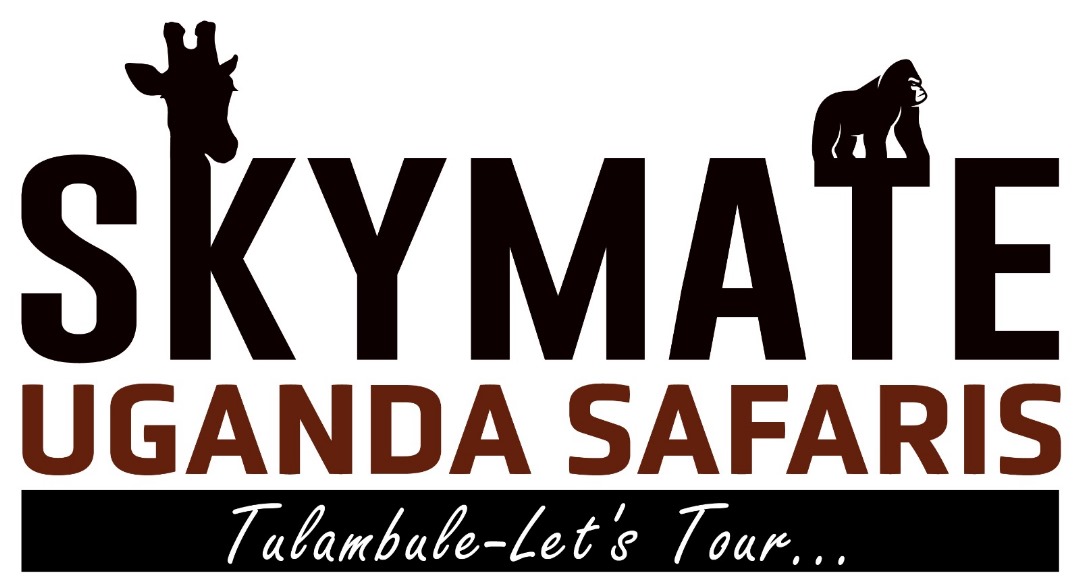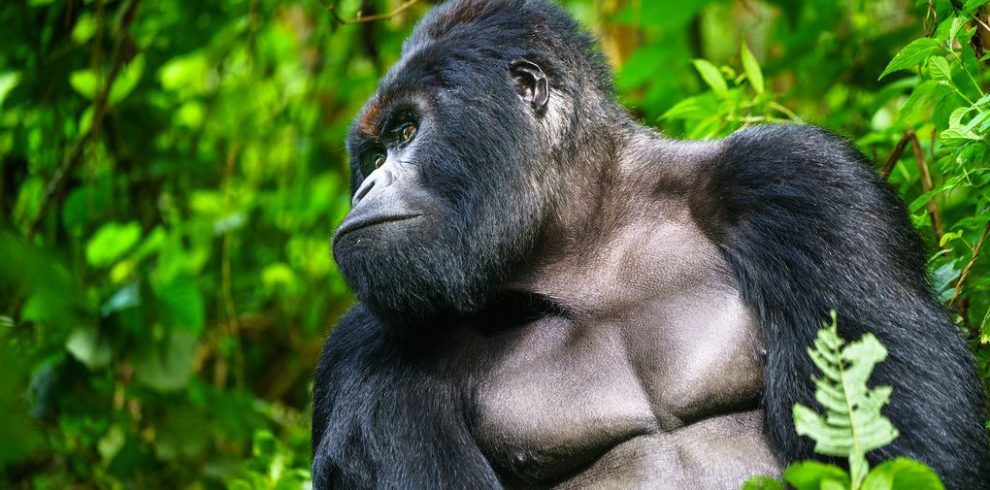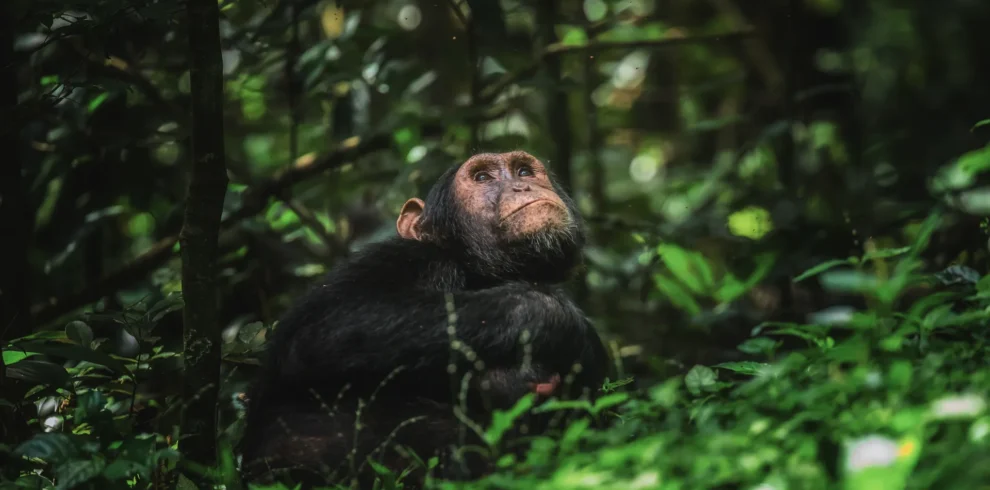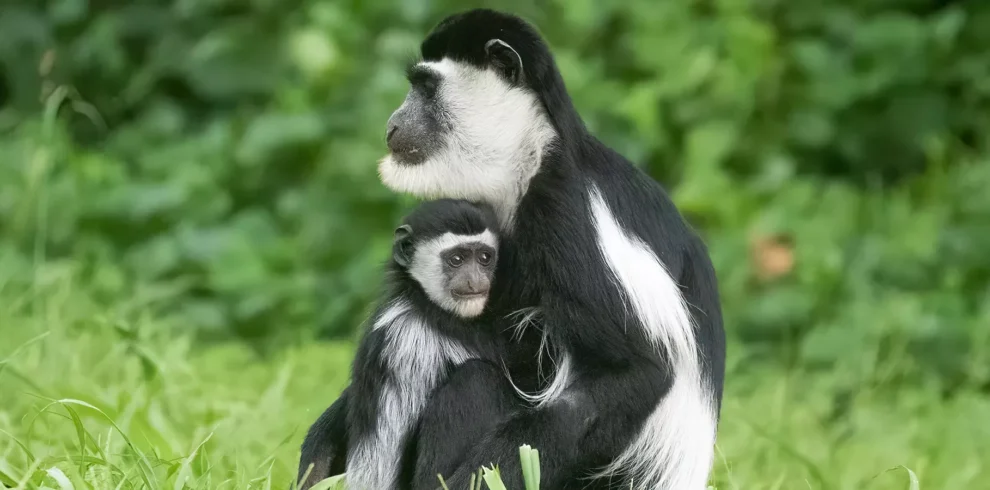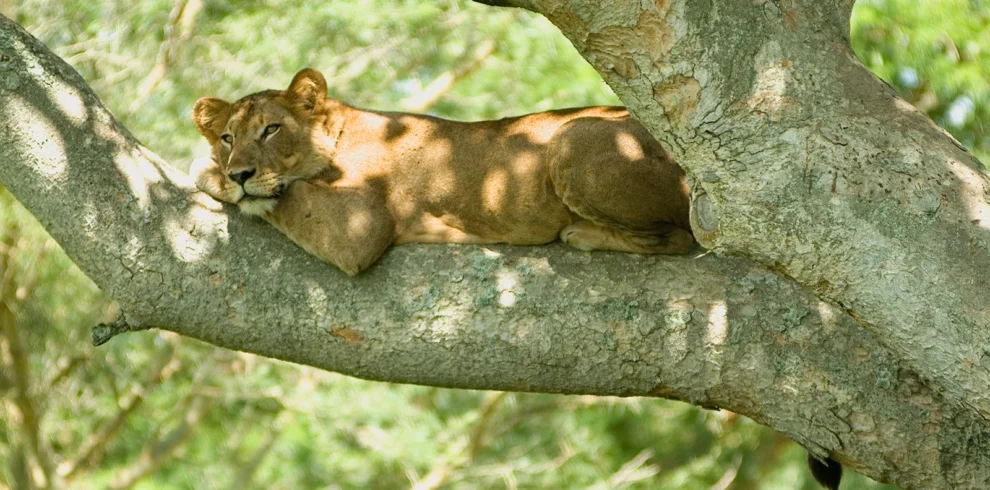Table of Contents
TogglePrimates in Uganda: Best Places To See Primates of Uganda
Discover all the unique primates in Uganda. Primates are some of the most amazing wild animals of Uganda. And Uganda is the dream destination for those in search of the absolute pinnacle of primate safaris in Africa. The country is home to half of the world’s mountain gorilla population, and seeing these apes in the wild is an experience unlike any other.
Beyond the gorillas, Uganda offers the best wild chimpanzee viewing in Africa, with a population of over 5000 chimps. Chimpanzees are also fascinating creatures to watch and they share almost 99% of their DNA with humans; they are our closest living relatives.
Uganda also counts over 20 species of monkeys inhabiting the various jungles from nocturnal Galagoes to the gorgeous Golden monkeys.
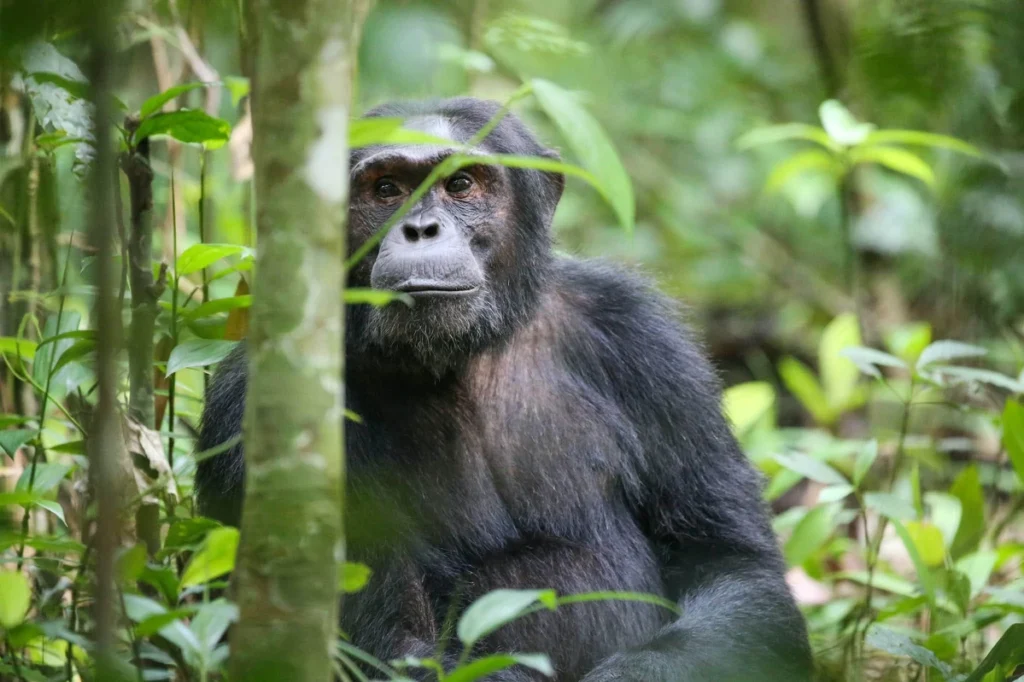
Best Places to See Primates in Uganda
- Bwindi Impenetrable National Park: This park is famous as a home to almost 50% of the world’s endangered mountain gorillas, which can be tracked by tourists.
- Kibale Forest National Park: Kibale is a prime location for chimpanzee trekking in Africa. It also has the highest density and diversity primates on the continent, with 13 different species living in this forest park.
- Queen Elizabeth National Park: This park is well-known for its diverse wildlife, including tree-climbing lions, chimpanzees and various monkey species like Vervet monkeys and baboons.
- Mgahinga Gorilla National Park: Like Bwindi Impenetrable Forest, this park is another habitat for the endangered mountain gorillas. It’s also home to rare golden monkeys.
- Semliki National Park: Semliki is home to several monkey species, including red-tailed monkeys, black-and-white colobus monkeys, and blue monkeys.
- Murchison Falls National Park: While known primarily for its majestic waterfall and savannah wildlife, this park also has olive baboons and ground-dwelling patas monkeys.
- Budongo Forest: Situated near Murchison Falls, Budongo is home to around 800 chimpanzees and several monkey species.
- Kalinzu Forest: This forest is located near Queen Elizabeth Nation Park and it is home to around 300 chimpanzees.
Uganda offers fantastic opportunities for primate enthusiasts and wildlife lovers to observe and study these remarkable creatures in their natural habitats.
Key Species of Primates in Uganda
Apes
The great apes are so closely related to humans that a less partial observer might well place them in the same family as us (it is thought that the chimpanzee is more closely related to humans than it is to any other ape). There are 4 ape species, of which 2 are found in Uganda.
1. Gorilla
A gorilla is the biggest member of the primate family. An adult gorilla may grow up to 1.8 meters tall and weigh up to 220 kilogram. Four sub-species of gorilla are recognized.
The most common race, the western lowland gorilla, is not present in Uganda, but an estimated 40,000 live in the rainforests of west and central Africa. The endangered Eastern lowland gorilla is restricted to patches of forest in eastern DRC, where there are estimated to be 4,000 animals.
The most threatened race of gorilla is the mountain gorilla.
The total number of Mountain Gorillas is now estimated at around 1063 (a significant increase over the past few years): at least 604 in the Virunga Mountains (shared between Uganda, DRC and Rwanda) and 459 in resident in Uganda’s Bwindi Impenetrable National Park. Gorilla trekking in Uganda provides a unique opportunity to observe these magnificent creatures up close.
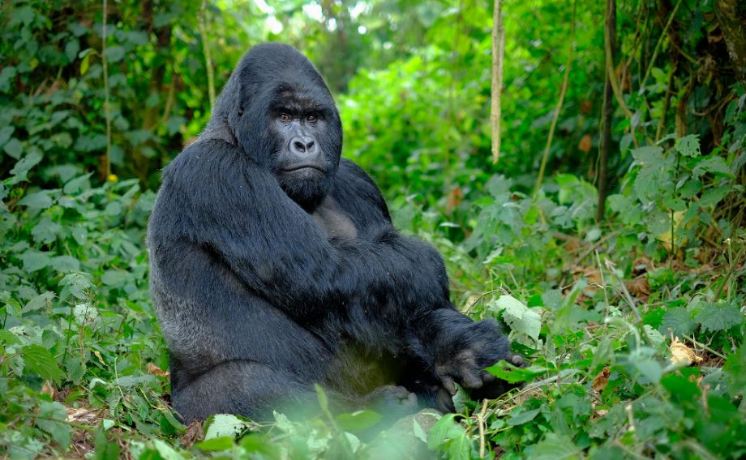
2. Chimpanzee
Chimpanzees are distinctive black-coated ape that are more closely related to man than to any other living creature. They live in large, loosely bonded communities based around a core of related males with an internal hierarchy topped by an alpha male.
Like humans, they tend to have strong personalities, and their expressive faces make their identities very recognizable to us. Their intelligence and social behavior are endlessly fascinating to observe, and no two visits to a community are the same.
Chimps are found in many national parks, with Kibale Forest being the most famous for chimpanzee tracking. These intelligent and social primates offer a fascinating experience for visitors. You can also see them in Kyambura Gorge in Queen Elizabeth National Park, Kalinzu Forest, Semliki Wildlife Reserve and the Budongo Forest near Murchison Falls National Park.
You may also like; best places to see chimpanzees in Uganda.
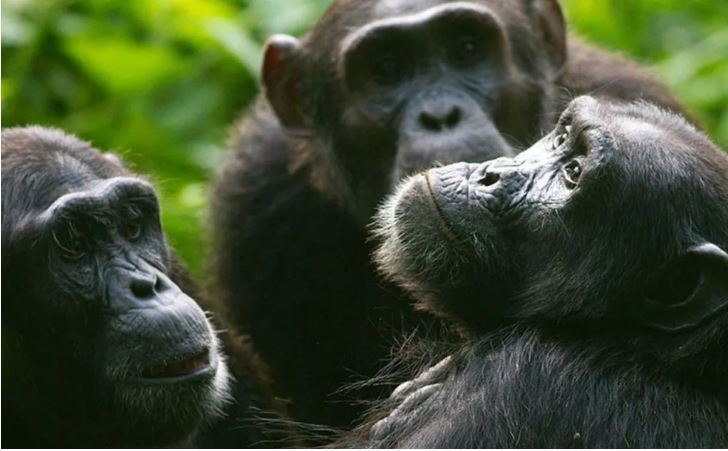
Monkeys in Uganda
All the monkeys found in Uganda are members of the family Cercopithecidae (Old World Monkeys). They fall into five genera: Colobus (closely related to the leaf-eating monkeys of Asia), Cercopithecus (guenons), Papio (baboons), Erythrocebus (patas) and Cercocebus (mangabeys).
1. Baboons
Heavily built and mainly terrestrial, baboons can be distinguished from any other monkey found in Uganda by their larger size and distinctive dog-like head. They live in large troops with a complex and rigid social structure held together by matriarchal lineages.
Four types of baboon live in sub—Saharan Africa and the only type that lives in Uganda is Olive baboon. Baboons are widespread and common in Uganda. They are frequently seen on the fringes of forest reserves and even along the roadside elsewhere in the country.

2. Patas monkey
Another terrestrial primate, restricted to the dry savanna of north-central Africa, the patas could be confused with the Vervet monkey, but it has a lankier build, a light reddish-brown coat, and a black stripe above the eyes (the Vervet is greyer and has a black face mask).
In Uganda, the patas monkey is restricted to the extreme north, where it can be seen in Kidepo Valley National Park and Murchison Falls National Parks, as well as the Pian Upe Wildlife Reserve. It is also known as the hussar monkey.
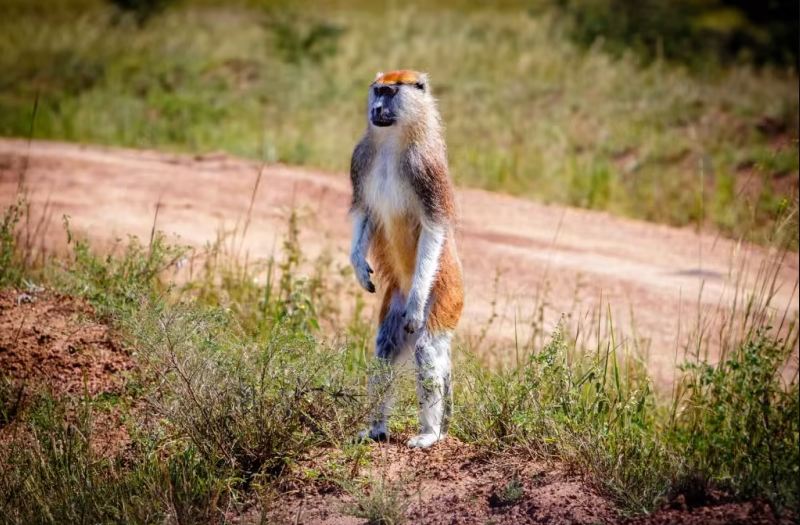
3. Vervet monkey
This light-grey monkey is readily identified by its black face and the male’s distinctive blue genitals. Associated with a wide variety of habitats, it’s the only monkey you’re likely to see them outside of forests and it is thought to be the most numerous monkey species in the world.
Vervet monkeys are widespread and common in Uganda, even outside of national parks, but they are absent from forest interiors and Afro—alpine habitats.
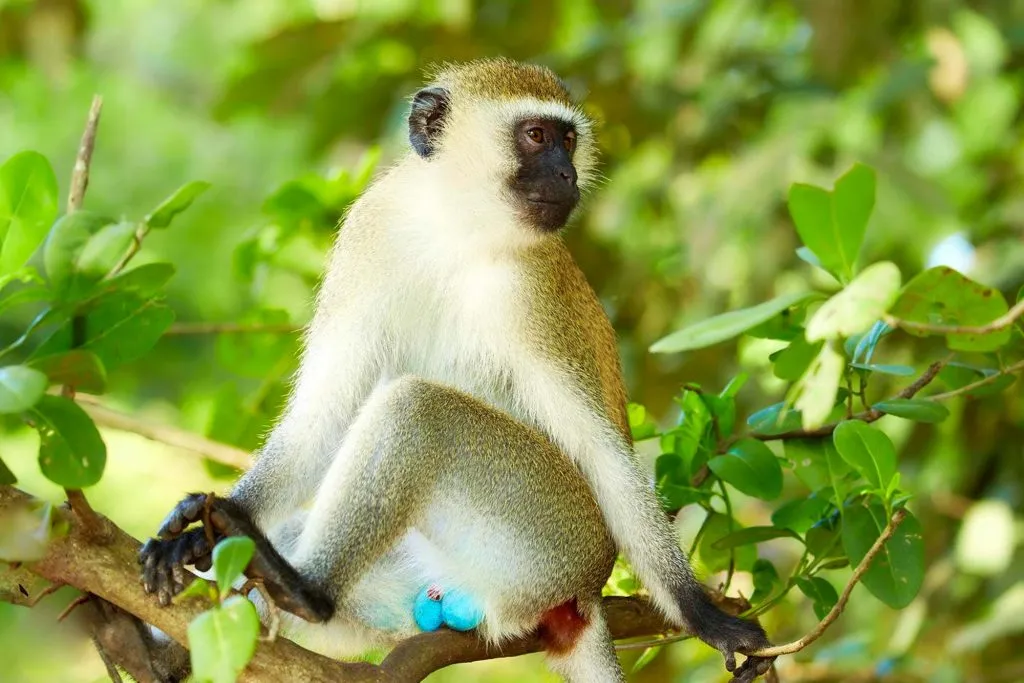
4. Blue monkey
The blue monkey is the most widespread forest monkeys in East Africa. It features uniform dark blue – grey in colour except its white throat and chest patch, with thick fur and backward – projecting hair on its forehead. The blue monkeys live in troops of between 4 and 12 animals and frequently associates with other primates.
They are also known as the Diademed guenon, Samango monkey, Sykes’s monkey, Gentle monkey and White – throated guenon. Blue monkeys occur in all but two of Uganda’s national parks (Murchison Falls National Park and Lake Mburo National Park being the exceptions) and in practically every other forest in the country.
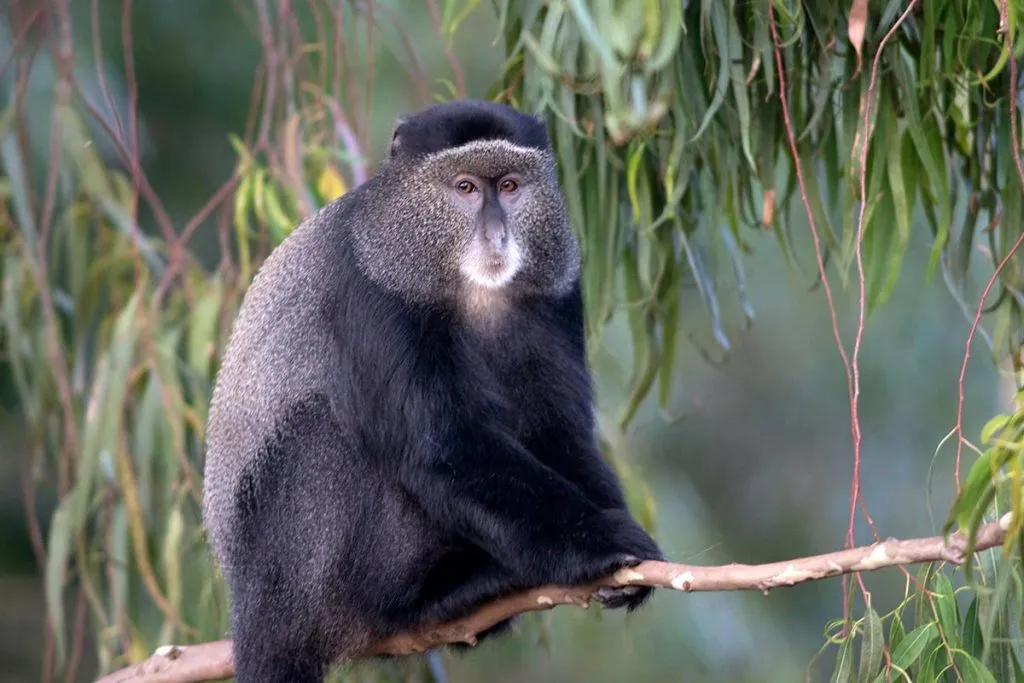
5. Golden Monkeys
The golden monkey is a local subspecies of blue monkey. They are endemic to high-altitude forests in the volcanic Virunga Mountains of Uganda, Rwanda and the Democratic Republic of Congo.
These monkeys are endearing; they are playful and inquisitive and often spend their time leaping between bamboo branches or frolicking on the forest floor.
They are some of the most beautiful monkey species because of their striking golden fur coats, thus the name ‘Golden’ Monkeys. They live in large groups called troops and love to feed on the bamboo shoot. One troop of Golden Monkeys has been habituated in Mgahinga Gorilla National Park which is available for tracking and research purposes.
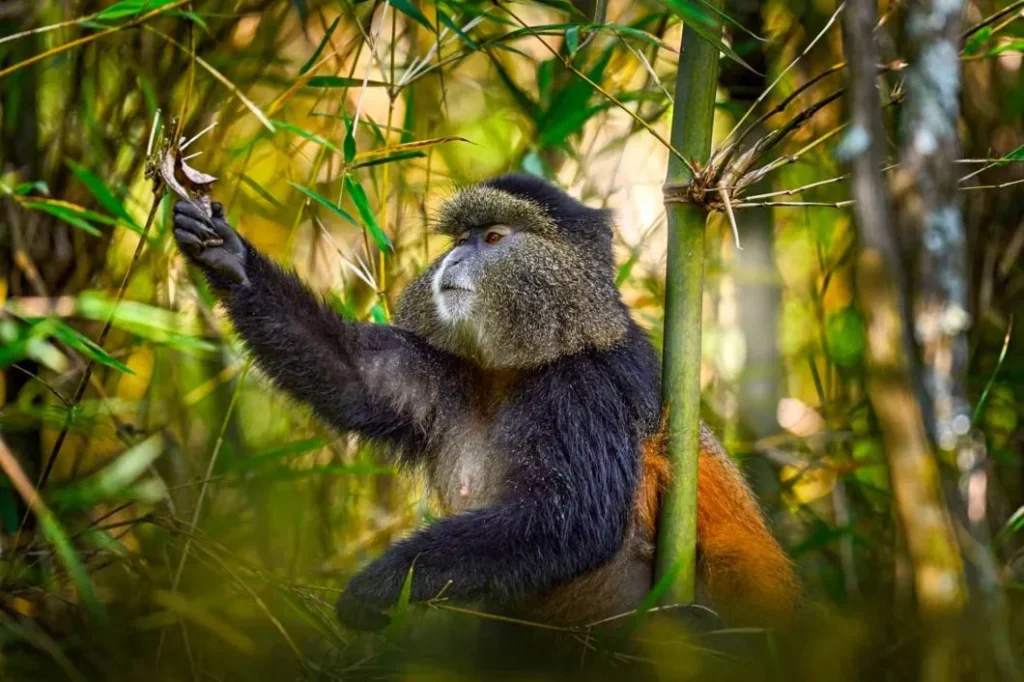
6. Red-tailed monkey
Another widespread forest monkey, the red-tailed monkey is brownish in appearance with white cheek whiskers, a coppery tail and a distinctive white, heart-shaped patch on its nose, giving rise to its more descriptive alternative name of black-cheeked white-nosed monkey.
It is normally seen singly, in pairs or in small family groups, but it also associates with other monkeys and has been known to accumulate in groups of up to 200.
Red-tailed monkeys occur in Kibale Forest, Bwindi, Semliki and Queen Elizabeth national parks, as well as in Budongo, Mpanga and several other forest reserves.
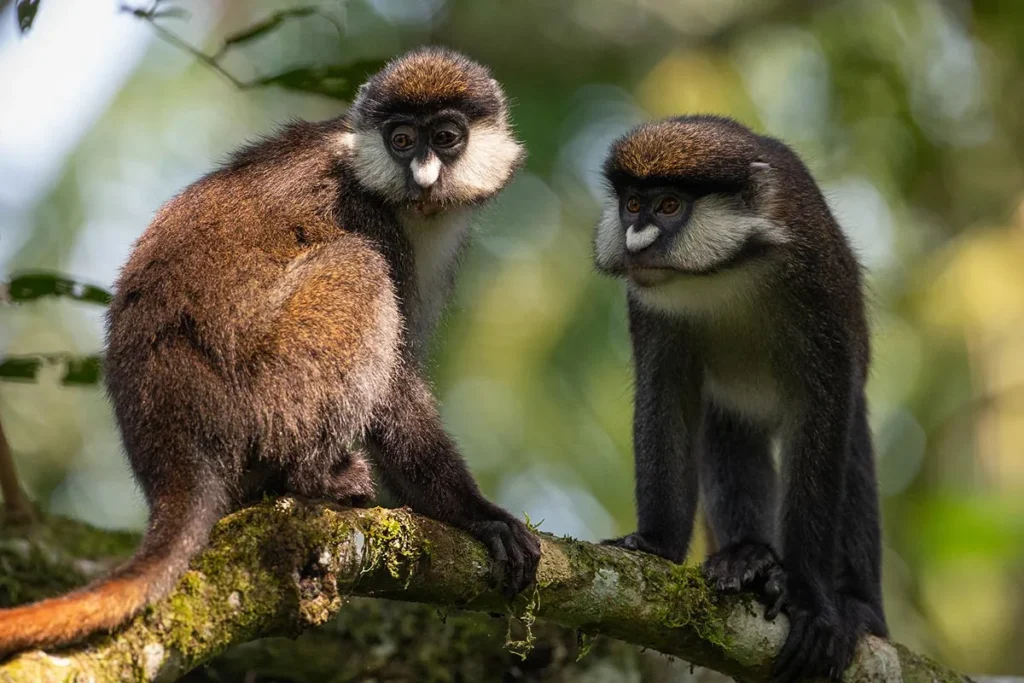
7. De Brazza’s monkey
This spectacular thickset monkey has a relatively short tail, a hairy face with a reddish-brown patch around its eyes, a white band across its brow and a distinctive white moustache and heard.
Primarily a West African species, De Brazza’s monkey is much localised in East Africa, most likely to be seen in the vicinity of Mount Elgon National Park and Semuliki National Park.
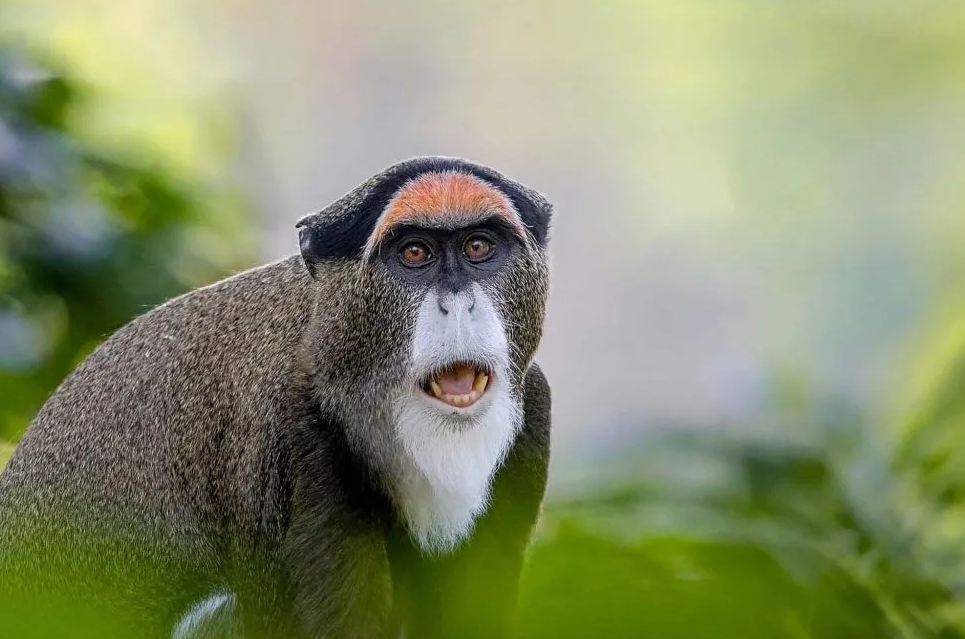
8. L’Hoest’s monkey
This handsome monkey is less well known and more difficult to see than most of its relatives, largely because of its preference for dense secondary forest in its terrestrial habits.
It has a black face and backward-projecting white whiskers that partially cover its ears. And is the only monkey which habitually carries its tail in an upright position. In Uganda, L’Hoest’s monkey is most likely to be seen in Kibale Forest, Bwindi or Maramagambo Forest in Queen Elizabeth National Park.
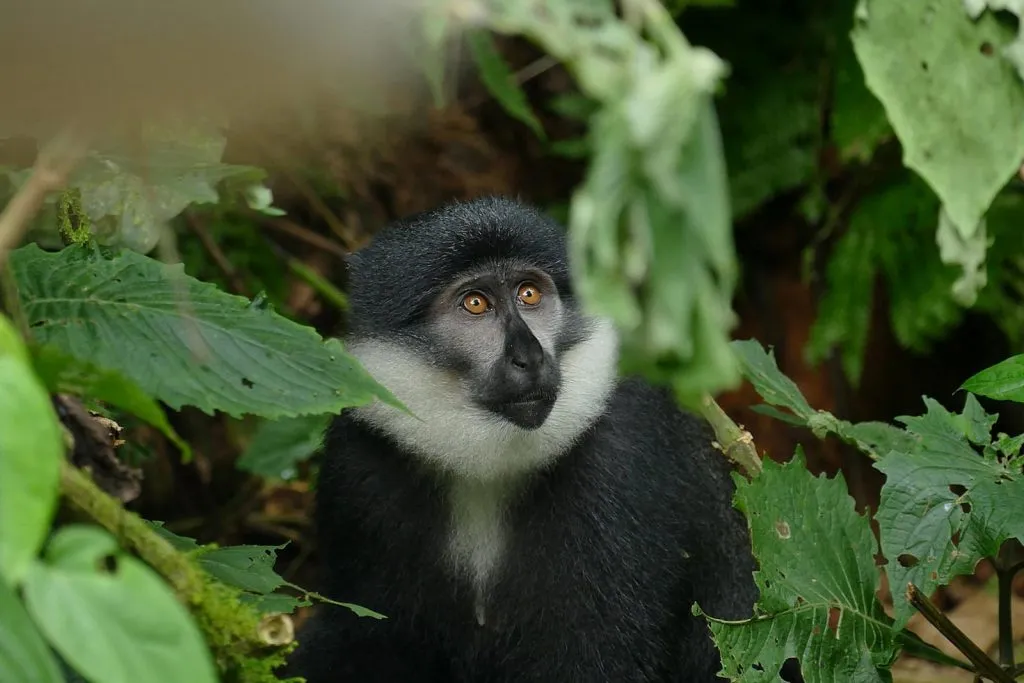
9. Grey-cheeked mangabey
This grayish-black monkey has few distinguishing features. It has baboon-like mannerisms, a shaggier appearance than any monkey, light-grey cheeks and a slight mane.
Grey-checked mangabeys live in lowland and mid-altitude forests. In Uganda, they are most likely to be seen in the Mabira Forest where you can do Mangabey tracking as well as Kibale Forest, where they are common, and in Semliki National Park.
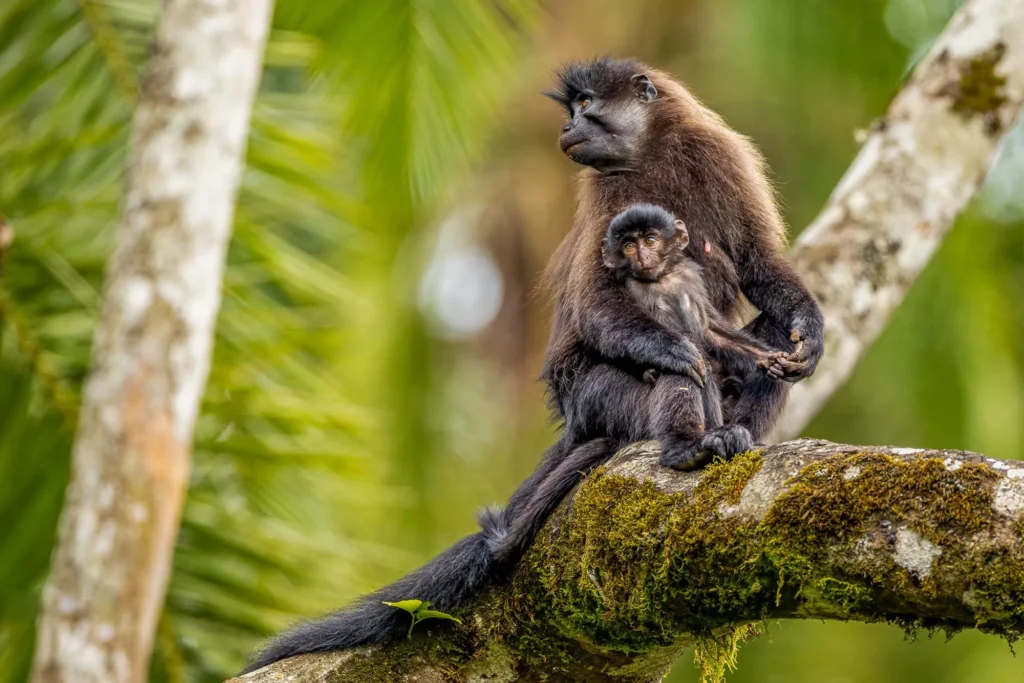
10. Black-and-white colobus
This beautifully marked and distinctive monkey has a black body, white facial markings, long white tail and, in some races, a white side-stripe. It lives in small groups and is almost exclusively arboreal. An adult is capable of Jumping up to 30 cm, a spectacular sight with its white tail streaming behind.
This is probably the most common and widespread forest monkey in Uganda, occurring in most sizable forest patches and even in well-developed riparian woodland.
The Rwenzori race of the closely related Angola colobus occurs alongside the black-and-white colobus in forested parts of the Rwenzori Mountains National Park.
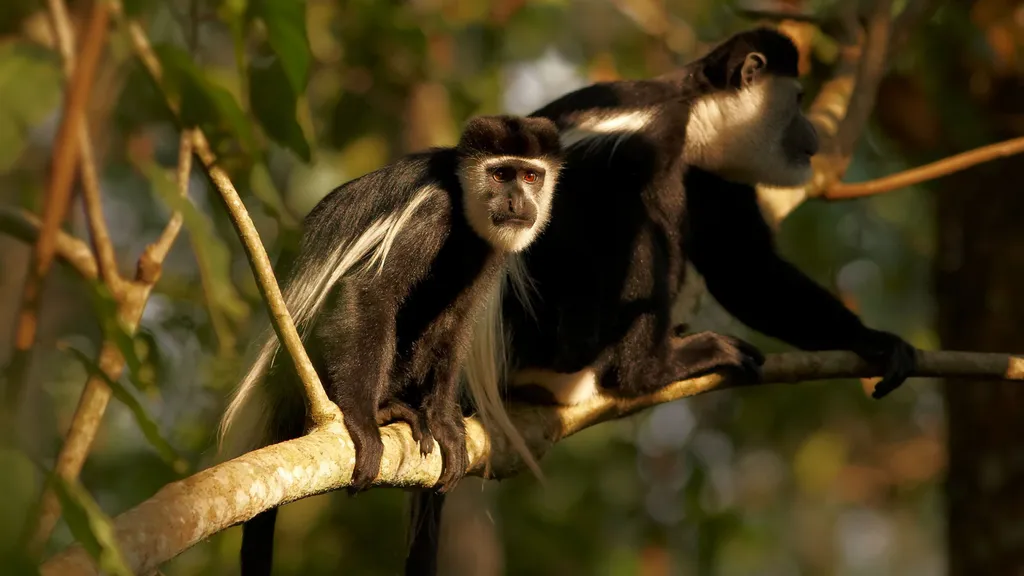
11. Red colobus
This relatively large red-grey monkey has few distinguishing features other than its slightly tufted crown. It is highly sociable and normally lives in scattered troops of 50 or more animals.
About 15 races of red colobus arc recognised, many of which are considered by some authorities to be distinct species. In Uganda, red colobus monkeys are largely restricted to Kibale Forest National Park and environs, where they are especially common in the Bigodi Wetland Sanctuary, though they do also occur in small numbers in Semliki National Park.
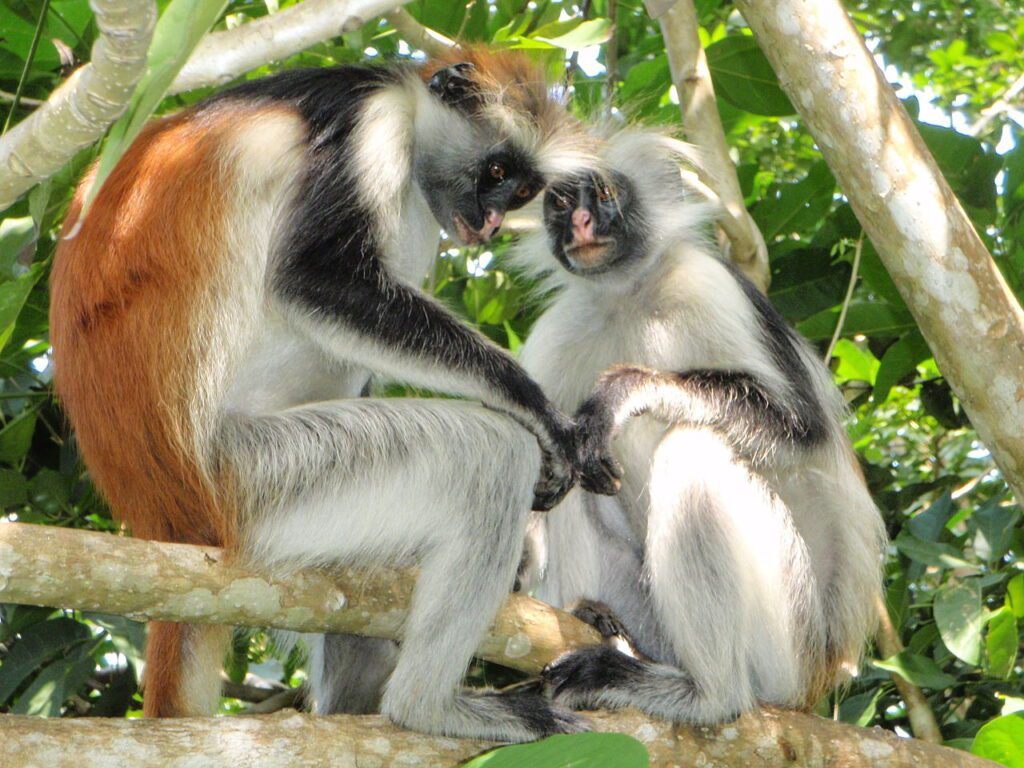
Nocturnal primates In Uganda
Rarely seen on account of their nocturnal habits, the prosimians are a relict group of primitive primates more closely related to the lemurs of Madagascar than to the diurnal monkeys and apes of the African mainland.
1. Bushbaby
Also called galago, this small, nocturnal primates are widespread in wooded habitats in Sub-Saharan Africa. The bushbaby’s piercing cry is one of the distinctive sounds of the African night.
If you want to see a Bushbaby, trace the cry to a tree, then shine a torch into it and you should easily pick out its large round eyes.
Five galago species are found in Uganda, of which the lesser bushbaby is the most common. An insectivorous creature, only 17cm long excluding its tail, the lesser bushbaby is a creature of wood land as opposed to true forest, and it has been recorded in all of Uganda’s savanna reserves.
The Eastern needle-clawed bushbaby, Thomas’s bushbaby, and dwarf bushbaby, all occur in the Kibale Forest National Park where you can see them on night walks. The dwarf bushbaby has also been recorded in Lake Mburo and Queen Elizabeth National Parks.
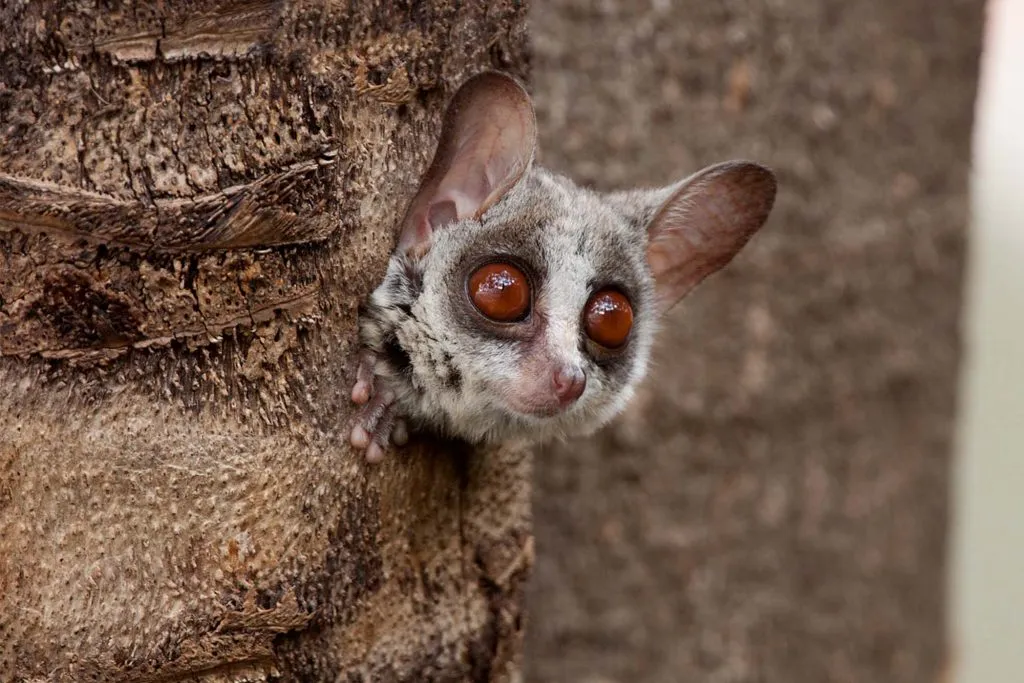
2. Potto
This medium-sized sloth-like creature inhabits forest interiors, where it spends the nights foraging upside down from tree branches.
It can sometimes be located at night by shining a spotlight into the canopy. The potto occurs in Kibale, Bwindi and Queen Elizabeth National parks. It also occurs in most other major Uganda rainforest reserves, and it is most likely to be seen on guided night walks in Kibale Forest National Park.
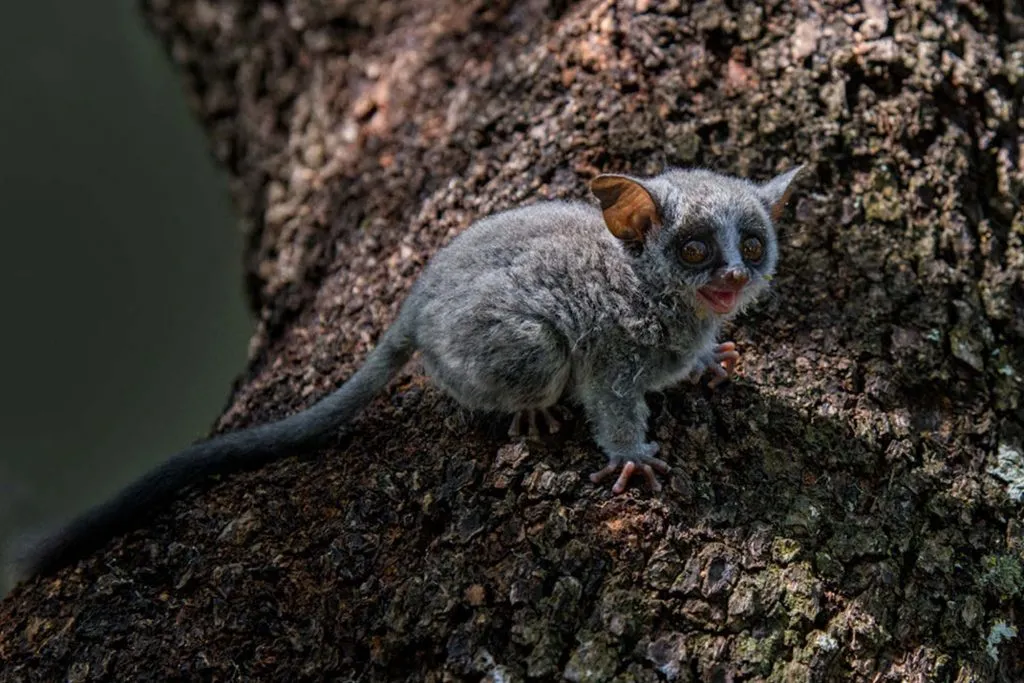
Best Time To See Primates In Uganda
The best time for primate trekking in Uganda is between its two dry seasons: December to February and between June and early September. These times are the best for trekking to see gorillas and chimpanzees. Read more about the best time to visit Uganda.
A Sample Of Our Best Uganda Primates Safaris
This 3 Day Gorilla Trekking Uganda tour is a short and affordable Uganda safari tour that takes you to the lush jungle...
This affordable 3-Day Kibale Chimp Trekking Tour takes you on a rewarding journey to Kibale Forest National Park in western Uganda. Kibale is one...
On this 8 Days Uganda Wildlife Safari, we take you on adventure that encompasses Uganda’s star attractions. There is trekking in...
Your remarkable 10 Days Uganda Wildlife Safari offers Gorilla trekking in Bwindi and Chimpanzee tracking in Kibale Forest, combined with amazing game...
Final Thought On Primates In Uganda
When visiting Uganda to see these primates, it is essential to follow ethical and sustainable tourism practices to ensure the conservation of these endangered species and their habitats. Many national parks offer guided primate tracking experiences to maximize your chances of seeing these incredible creatures while minimizing disturbance to their natural environment.
